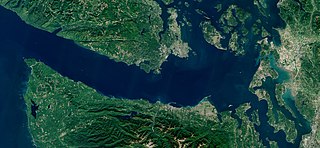
The Strait of Juan de Fuca is a body of water about 96 miles long that is the Salish Sea's main outlet to the Pacific Ocean. The international boundary between Canada and the United States runs down the centre of the Strait.
A ferry is a ship, watercraft or amphibious vehicle used to carry passengers, and sometimes vehicles and cargo, across a body of water. A passenger ferry with many stops, such as in Venice, Italy, is sometimes called a water bus or water taxi.
British Columbia Ferry Services Inc., operating as BC Ferries (BCF), is a former provincial Crown corporation, now operating as an independently managed, publicly owned Canadian company. BC Ferries provides all major passenger and vehicle ferry services for coastal and island communities in the Canadian province of British Columbia. Set up in 1960 to provide a similar service to that provided by the Black Ball Line and the Canadian Pacific Railway, which were affected by job action at the time, BC Ferries has become the largest passenger ferry line in North America, operating a fleet of 36 vessels with a total passenger and crew capacity of over 27,000, serving 47 locations on the B.C. coast.

Washington State Ferries (WSF) is a government agency that operates automobile and passenger ferry service in the U.S. state of Washington as part of the Washington State Department of Transportation. It runs ten routes serving 20 terminals located around Puget Sound and in the San Juan Islands, designated as part of the state highway system. The agency maintains the largest fleet of ferries in the United States at 21 vessels. In 2021, the system had a ridership of about 46,900 per weekday as of the second quarter of 2022. As of 2016, it was the largest ferry operator in the United States and the second-largest vehicular ferry system in the world.

The Alaska Marine Highway (AMH) or the Alaska Marine Highway System (AMHS) is a ferry service operated by the U.S. state of Alaska. It has its headquarters in Ketchikan, Alaska.

The Burnaby class is a ship class of ferries in the BC Ferries' fleet, built between 1964 and 1965. There are two ships in this class: MV Queen of Burnaby and MV Queen of Nanaimo. Both are propelled by controllable-pitch propellers. Both were built with two Mirrlees National KVSSM, V-16, 4 stroke-cycle, diesel engines, each producing 3,000 brake horsepower (2,200 kW) at 320 revolutions per minute.
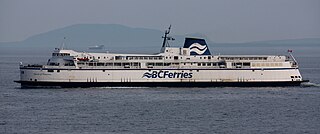
MV Queen of Nanaimo is a Burnaby-class passenger vessel that was operated by BC Ferries from the time it entered service in 1964 until 2017. Queen of Nanaimo was used to ferry passengers and vehicles from mainland British Columbia, Canada to the islands off its coast. In 2017, the vessel was sold to Goundar Shipping Ltd. and renamed MV Lomaiviti Princess V for service in Fiji.

The V-class ferries, also known as the Victoria class, originally included seven ferries operated by BC Ferries built between 1962 and 1965. The V class were a continuation of the previous Sidney-class design with some cosmetic changes and different engines. These vessels were the backbone of service on the Tsawwassen – Swartz Bay route prior to the arrival of MV Spirit of British Columbia in 1993. Four of these vessels underwent vehicle capacity increases three times. The lead ship of the class, Queen of Victoria suffered significant damage in a collision in 1970.
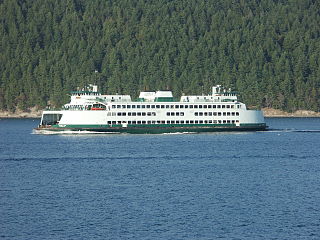
The MV Chelan is an Issaquah-class ferry operated by Washington State Ferries, completed and in service in 1981. In 2004, the vessel was refit with a second vehicle deck, and in 2005 was refit with safety equipment to meet the requirements of the International Convention for the Safety of Life at Sea (SOLAS), allowing the Chelan to make international trips on the Anacortes–San Juan Islands–Sidney, British Columbia route. As of April 2020 the Chelan is the only vessel in the Washington State Ferries fleet that meets SOLAS standards.

The Puget Sound Navigation Company (PSNC) was founded by Charles E. Peabody in 1898. Today the company operates an international passenger and vehicle ferry service between Port Angeles, WA and Victoria, BC on the Coho.
Victoria Express, also known as Victoria Rapid Transit, was the name of a private, seasonal ferry operation based in Port Angeles, Washington. The service operated two passenger-only ferries on routes between Port Angeles and Victoria, British Columbia and Friday Harbor, Washington during the summer, the 149-seat, 105-foot (32 m) Victoria Express and the 120-foot (37 m) Victoria Express II. Both ferries are gyroscopically stabilized.

The Sidney class consisted of two roll-on/roll-off ferries, Queen of Sidney and Queen of Tsawwassen, built for the British Columbia Ferry Corporation in service from 1960 to 2008. The design for the ships was based on the ferry MV Coho with changes made to accommodate loading of vehicles through the bow of the vessel. Both vessels serviced different routes throughout their service lives.

The U.S. state of Washington is home to a number of public and private ferry systems, most notably the state-run Washington State Ferries.
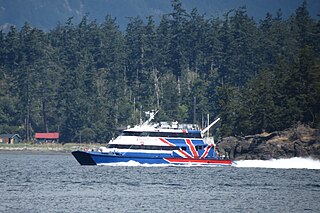
Clipper Navigation, Inc., is a subsidiary of Förde Reederei Seetouristik based in Seattle Washington, that provides multiple transportation and vacation packages—many of which are offered under the name Clipper Vacations—including hotel and tour packages in Victoria, Seattle, Vancouver, Friday Harbor, Portland, Whistler, the Canadian Rockies and Kelowna.

Asbury Park was a high-speed coastal steamer built in Philadelphia, and intended to transport well-to-do persons from New York to summer homes on the New Jersey shore. This vessel was sold to West Coast interests in 1918, and later converted to an automobile ferry, serving on various routes San Francisco Bay, Puget Sound and British Columbia. This vessel was known by a number of other names, including City of Sacramento, Kahloke, Langdale Queen, and Lady Grace.

MV Spirit of British Columbia is an S-class ferry, part of the BC Ferries fleet active along the British Columbia coast. It and Spirit of Vancouver Island represent the two largest ships in the fleet. The ship was completed in 1993 and serves the Tsawwassen–Swartz Bay route. In 2018, it underwent a mid-life refit that included conversion to a dual-fuel system that allows it to use either marine diesel oil or liquefied natural gas.

Princess Marguerite, Princess Marguerite II, and Princess Marguerite III was a series of Canadian coastal passenger vessels that operated along the west coast of British Columbia and into Puget Sound in Washington state almost continuously from 1925 to 1999. Known locally as "the Maggie", they saw the longest service of any vessel that carried passengers and freight between Victoria, Vancouver, and Seattle. The vessels were owned and operated by a series of companies, primarily Canadian Pacific Railway Company (CPSS) and British Columbia Steamships Corporation. The first two were part of the CPR "Princess fleet," which was composed of ships having names which began with the title "Princess". These were named after Marguerite Kathleen Shaughnessy, who was not a princess but was the daughter of Baron Thomas Shaughnessy, then chairman of the board of CPSS's parent, the Canadian Pacific Railway (CPR).
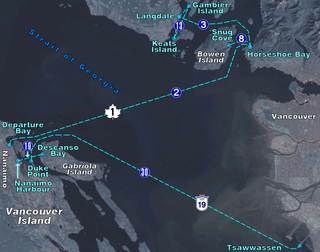
The Bowen Island ferry travels between Snug Cove on Bowen Island, and Horseshoe Bay in the District of West Vancouver, British Columbia, Canada, a trip of three nautical miles across Howe Sound. A scheduled ferry has been in operation since 1921, when Bowen Island was a popular holiday destination. Prior to that year, transportation to the island was by steamship from Vancouver, with only one trip daily. The Bowen Island ferry used a fleet of small passenger vessels until 1956, when a single car ferry began passenger service, and that ferry began carrying vehicles in 1958. In 2021 the route carried in excess of 1 million passengers plus 500,000 vehicles.
MV Motor Princess was a vehicle and passenger ferry built for Canadian Pacific in 1923. She was later renamed, Pender Queen then Pender Lady.

MV Chinook was an automobile ferry that operated between Seattle, Port Angeles and Victoria under the ownership of Puget Sound Navigation Company.


















